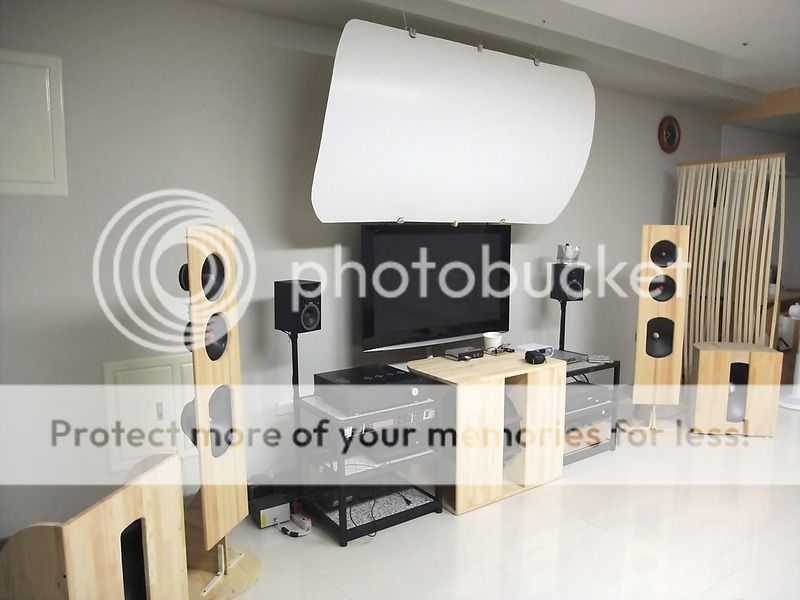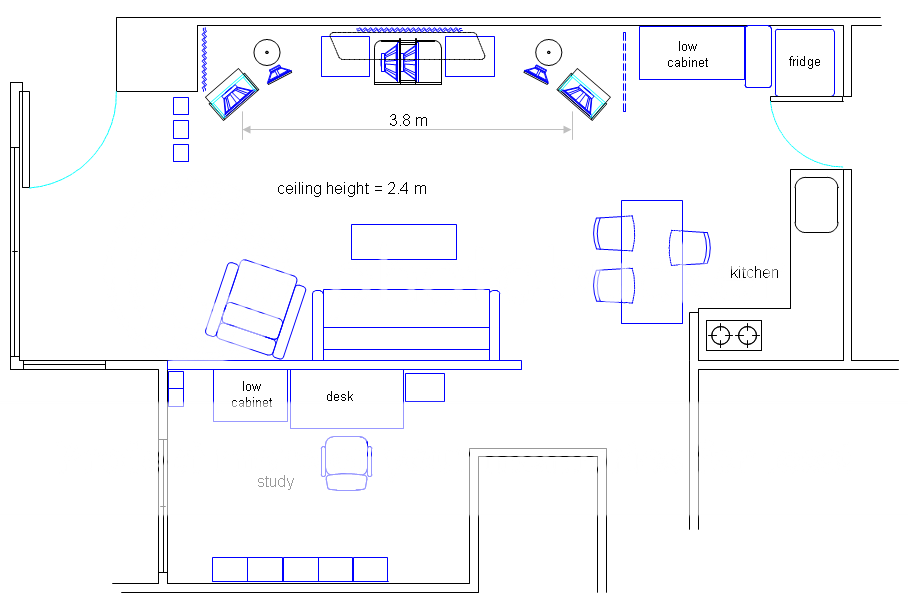By the way, James Croft proposed two solutions to the "sound from the floor" problem in the thread I had linked earlier. Please see http://www.faktiskt.se/modules.php?name=Forums&file=viewtopic&p=1110176#1110176
I don't think the HRTF-approach works reliably but the Allison-like approach of placing the woofer/mid boundary-coupled and the tweeter at ear height looks promising for a wide dispersion design.
I don't think the HRTF-approach works reliably but the Allison-like approach of placing the woofer/mid boundary-coupled and the tweeter at ear height looks promising for a wide dispersion design.
Last edited:
There are many systems employing 3D stereo field. Ambisonic comes to mind firstOthers include 3D vector amplitude panning, like the one proposed by Lokki.
and what about the precedence effect?
I don't understand the point. Sound direction can be localised without any reflections. In Snell Type 1 there is strong direct sound from the tweeter, which can result to image localised low.
I thought we have agreed that what is needed is optimal direct/reflected sound ratio in "Type 1" there was strong direct sound but also strong reflected sound
and the sound was NOT coming from the floor
Yes there was a big difference in the treble range. I posted measurements long ago in some of these threads.
treble range that is precisely? how big? I ask because it seems to be important for the FCUFC to work best
Is your tweeter a horn tweeter ? How is the directivity ?
it uses Dayton H12RW 12" waveguide IIRC so it´s effectively a virtual ceiling tweeter, an entirely different FCUFC implementation than "Type 1"
and what about the precedence effect?
I thought we have agreed that what is needed is optimal direct/reflected sound ratio in "Type 1" there was strong direct sound but also strong reflected sound
As a rule of thumb, reflected and delayed sound must have a little bit higher amplitude than the direct sound in order the direct sound not to be perceived as a sound source.
In snell type 1 I cannot see how this would happen ? And, there is no vertical directivity pattern plots of Snell speaker ?
treble range that is precisely? how big? I ask because it seems to be important for the FCUFC to work best
The speaker I was using for the test started to have narrowing directivity somewhere above about 3-4 kHz I think.
As a rule of thumb, reflected and delayed sound must have a little bit higher amplitude than the direct sound in order the direct sound not to be perceived as a sound source.
In snell type 1 I cannot see how this would happen ?
If the dispersion is really wide then there are higher order reflections that are likely lumped together (perceptually). Would be interesting if someone could take the time to look at this more thoroughly.
As a rule of thumb, reflected and delayed sound must have a little bit higher amplitude than the direct sound in order the direct sound not to be perceived as a sound source.
If the dispersion is really wide then there are higher order reflections that are likely lumped together (perceptually). Would be interesting if someone could take the time to look at this more thoroughly.
Elias - you have to be careful quoting those results because, as I have pointed out before, they refer to a shift in the "principle source location" and say nothing about image blur or coloration - the two things that I consider the most important. The precedence effect is widely over used in audio to explain things. Most of the work that was done simply does not apply to the real problems in audio - imaging, coloration and spaciousness.
Elias - you have to be careful quoting those results because, as I have pointed out before, they refer to a shift in the "principle source location" and say nothing about image blur or coloration - the two things that I consider the most important.
As a rule of thumb, reflected and delayed sound must have a little bit higher amplitude than the direct sound in order the direct sound not to be perceived as a sound source.
"Image Blur" and "Coloration" from reflections are however interesting topics.
"Image Blur" I'm aware of - a diffused effect of an "image". Which I rarely find to be far from reality (..when compared to a real sound source with eyes closed listening). In fact sometimes the result seems to be closer to reality, but occasionally worse depending on how close the loudspeaker is to the wall and how reflective the wall is.
As for "Coloration" though, at least at higher freq.s.. I'm somewhat at a loss here for a "definition".
I have heard conditions where there were broad-band changes (like a "tilted-up" freq. response) - but not something I'd characterize as a "coloration". Moreover most people seem to adapt to the alteration from "flat".
The only time I've heard of significant coloration at higher freq.s was from direct sound (i.e. the combination and combing effects of L+R, particularly on vocals), not from any reflection. (..of course modal effects and floor/ceiling "bounce" will almost certainly provide a "narrow-band" coloration, but that's at lower freq.s.)
I thought we have agreed that what is needed is optimal direct/reflected sound ratio in "Type 1" there was strong direct sound but also strong reflected sound
and the sound was NOT coming from the floor
The goal with the Type 1 is to have the reflected sound in phase with the direct. Its no different than ground plane measurements. As you take an ear level mic and move it towards the ground the air path and the ground bounce path get closer in time. The cancellation nulls move up in frequency and, eventually, all audio frequencies are in phase. The direct and reflected become inseparable.
The woofer can be above the floor surface a few inches, but the tweeter can't, hence the ramp and the notch to get the tweeter center at the reflecting plane.
On top of it all you get a bonus +6dB.
David S
it uses Dayton H12RW 12" waveguide IIRC so it´s effectively a virtual ceiling tweeter, an entirely different FCUFC implementation than "Type 1"
Yes, correct, that's what I'm using. Thank you.
BTW, I don't know why the diffused HF can sound pretty clear. For example, the triangle at the far corner of a big orchestra is sounding just the way it should -- distant, small, crisp and clear. Both spaciousness and imaging are very good.
Flooder tweeters aside, the directivity of the central channel DML panel is very wide, too. The panel is quite large (180x90cm), with a very uniform half-space radiation.
So basically the HF in this (very reflective) room is everywhere. Why can I pinpoint that little tiangle in the whole (sound-)space? I can't explain.
Why can I pinpoint that little tiangle in the whole (sound-)space?
I have been asking the question on diyaudio for over 4 years now.
Most resident experts here keep answering like "you cannot", "you like bad un-hifi sound of everything sounds the same" or just "you are plain stupid/lunatic" etc.
Recently I also got a warning from moderators too. I still wonder what is it for?
anyway - what a beautiful, clear and complete schematic
BTW the picture of Your system deserves to be reposted here:

best,
graaf
I see two reasons:BTW, I don't know why the diffused HF can sound pretty clear. For example, the triangle at the far corner of a big orchestra is sounding just the way it should -- distant, small, crisp and clear. Both spaciousness and imaging are very good. ...
So basically the HF in this (very reflective) room is everywhere. Why can I pinpoint that little tiangle in the whole (sound-)space? I can't explain.
1) From our evolutionary experience (don't have a better word for it) we know, that the source of a high-frequency-only sound with a sharp rising transient must be small. Physics dictate that.
2)Look at this paper: http://decoy.iki.fi/dsound/ambisonic/motherlode/source/A%20new%20approach%20to%20the%20assessment%20of%20stereophonic_Bennett%20et%20al_1985.pdf
It discusses why our ear/brain can't place high-frequency-only sources precisely on the stereo scene. If in doubt our brain has a tendency to move them to the sides of the acoustic scene. Did it ever appear to you that you hear those triangles mostly from the center or the outer limits of your acoustic scene, but rarely from say 20°?
Rudolf
Last edited:
Yes, correct, that's what I'm using. Thank you.
BTW, I don't know why the diffused HF can sound pretty clear. For example, the triangle at the far corner of a big orchestra is sounding just the way it should -- distant, small, crisp and clear. Both spaciousness and imaging are very good.
Flooder tweeters aside, the directivity of the central channel DML panel is very wide, too. The panel is quite large (180x90cm), with a very uniform half-space radiation.
So basically the HF in this (very reflective) room is everywhere. Why can I pinpoint that little tiangle in the whole (sound-)space? I can't explain.
Thanks for the pictures. Now it would be interesting to hear how you would rate the "locatedness" of sounds in your room with high directivity speakers like the Danley SH-50.
Rudolf already commented on the perceptual aspects of "good" locatedness in a reflective environment.
Thanks for the pictures. Now it would be interesting to hear how you would rate the "locatedness" of sounds in your room with high directivity speakers like the Danley SH-50.
and how You rate it Markus in Your room? with Danley SH-50?
I see two reasons:
You seem to assume that only triangles sound good - that is appropriately focused and localised - in CLS's system, why?

Guys, please respect other members differing views and don't try and force issues and personal opinions by talking anyone down or poking fun at anyone.
In other words play nicely
And for anyone not sure of the rules,
http://www.diyaudio.com/forums/site-announcements/167561-diyaudio-rules.html
- Home
- Loudspeakers
- Multi-Way
- The Advantages of Floor Coupled Up-Firing Speakers

